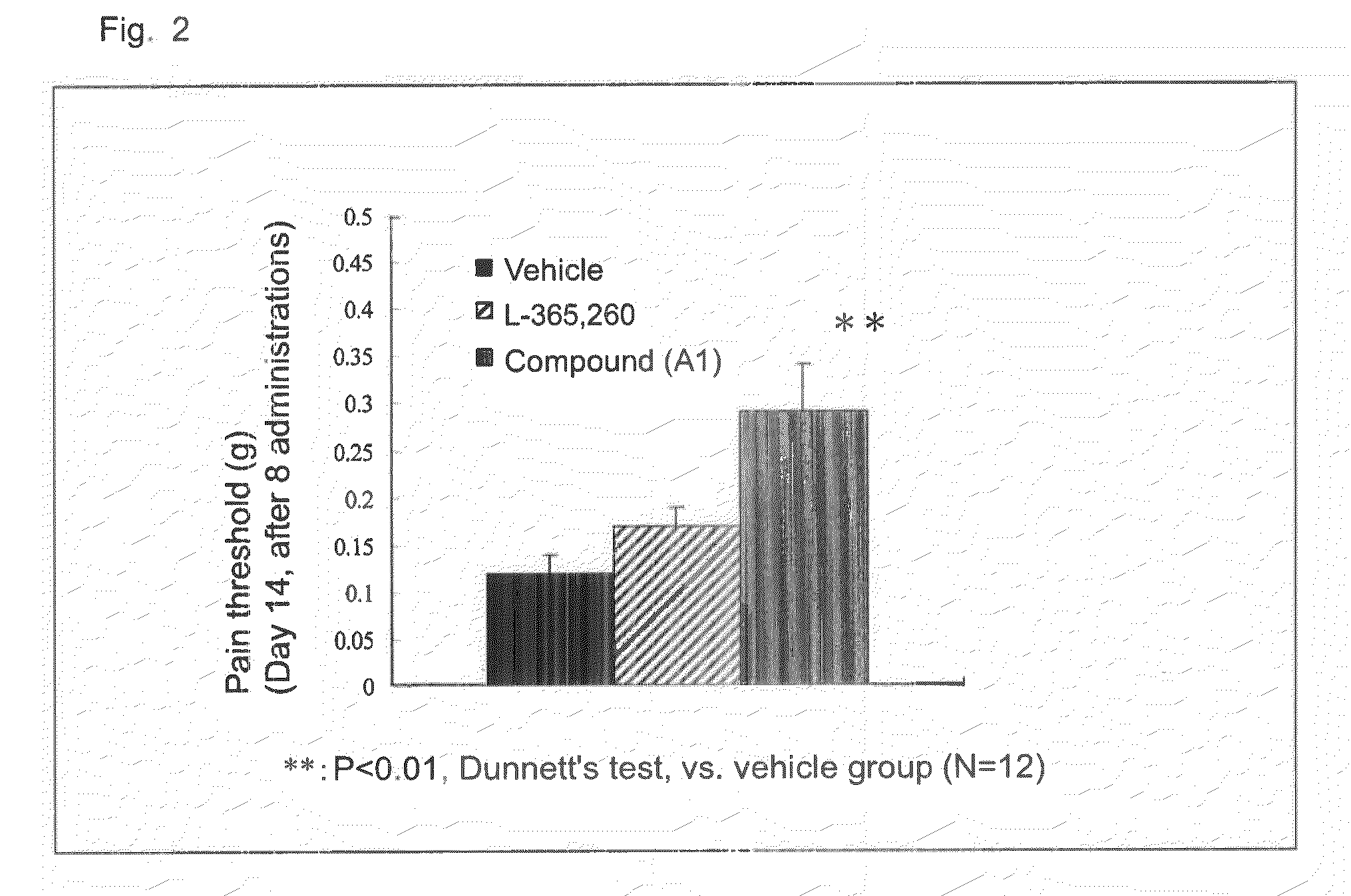Therapeutic agent for pain
a technology of pain treatment and pain medication, applied in the direction of anti-inflammatory agents, biocide, drug compositions, etc., can solve the problems of withdrawal symptoms, adverse side effects, withdrawal symptoms, etc., and achieve the effect of no cancer, no toxic side effects, and simple dosage form
- Summary
- Abstract
- Description
- Claims
- Application Information
AI Technical Summary
Benefits of technology
Problems solved by technology
Method used
Image
Examples
example 1
[0069]A B16-BL6 melanoma cell solution was subcutaneously injected into the plantar region of a right paw of a mouse by means of a syringe and injection needle, to thereby transplant melanoma cells into the mouse (2×105 cells / mouse). After completion of cancer transplantation, the plantar region of the paw of each mouse was probed with von Frey filaments to thereby give contact stimulation to the paw, and pain threshold (load of filaments (g) required for withdrawal of the paw upon contact stimulation) was monitored. On day 14 after cancer transplantation, when the pain threshold considerably decreased to a constant value, a calcium salt of compound A (compound A1) was administered singly to the mouse. Then, the change in pain threshold was monitored. Compound (A1) was suspended in 0.5% CMC-Na solution before administration. FIG. 1 shows the results. In a cancer pain model, allodynia (i.e., pain caused by a contact stimulus that generally induces no pain) occurred, and the pain thre...
example 2
[0070]A B16-BL6 melanoma cell solution was subcutaneously injected into the plantar region of a right paw of a mouse by means of a syringe and injection needle, to thereby transplant melanoma cells into the mouse (2×105 cells / mouse). After completion of cancer transplantation, the plantar region of the paw of each mouse was probed with von Frey filaments to thereby give contact stimulation to the paw, and pain threshold (load of filaments (g) required for withdrawal of the paw upon contact stimulation) was monitored. From day 7 after cancer transplantation, compound (A1) or L-365,260 (CCK2 receptor antagonist) (100 mg / kg) was orally administered once a day for eight days repeatedly, and the change in pain threshold was monitored. FIG. 2 shows the results. On day 7 after cancer transplantation, allodynia occurred, and a considerable drop in pain threshold occurred on day 14 after cancer transplantation. Peroral administration of compound (A1) elevated pain threshold, to thereby impro...
example 3
[0071]A B16-BL6 melanoma cell solution was subcutaneously injected into the plantar region of a right paw of a mouse by means of a syringe and injection needle, to thereby transplant melanoma cells into the mouse (2×105 cells / mouse). After completion of cancer transplantation, the plantar region of the paw of each mouse was probed with von Frey filaments to thereby give contact stimulation to the paw, and pain threshold (load of filaments (g) required for withdrawal of the paw upon contact stimulation) was monitored. On day 14 after cancer transplantation, a compound A calcium salt (compound A1) (100 mg / kg) and morphine hydrochloride (2.5 mg / kg) were administered in combination. As a result, as shown in FIG. 3, the group of combined administration of compound A1 and morphine exhibited high anti-allodynia effect, as compared with the compound A1 sole administration group and the morphine sole administration group.
PUM
| Property | Measurement | Unit |
|---|---|---|
| Time | aaaaa | aaaaa |
Abstract
Description
Claims
Application Information
 Login to View More
Login to View More - R&D
- Intellectual Property
- Life Sciences
- Materials
- Tech Scout
- Unparalleled Data Quality
- Higher Quality Content
- 60% Fewer Hallucinations
Browse by: Latest US Patents, China's latest patents, Technical Efficacy Thesaurus, Application Domain, Technology Topic, Popular Technical Reports.
© 2025 PatSnap. All rights reserved.Legal|Privacy policy|Modern Slavery Act Transparency Statement|Sitemap|About US| Contact US: help@patsnap.com



